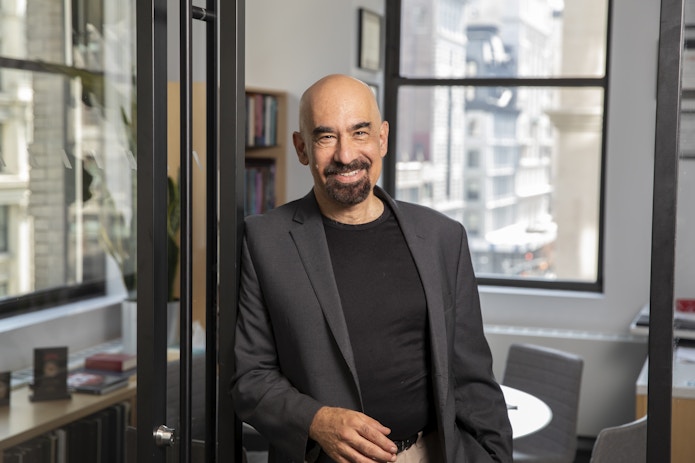Simons Foundation Selects Astrophysicist David Spergel as Next President

The Simons Foundation today announces that David Spergel, an accomplished astrophysicist and winner of the prestigious Breakthrough Prize, will be the foundation’s next president, effective July 1, 2021. Spergel currently serves as director of the Center for Computational Astrophysics at the Simons Foundation’s Flatiron Institute in New York City.
Spergel will take the reins from Simons Foundation co-founder Marilyn Simons, who has served as president since she founded the philanthropy with Jim Simons in 1994.
“Over the past 25 years, Jim and Marilyn have built a foundation with a worldwide reputation for supporting the very best in science and science education,” Spergel says. “I am excited about playing a role in continuing to build on the tradition of excellence that they have established.”
Marilyn Simons will co-chair the Simons Foundation’s board of directors alongside Jim Simons after Spergel assumes the presidency. “David is dynamic, imaginative, forward-thinking and inspiring,” she says. “As president of SF, David will do a superb job of directing fundamental research efforts to advance our knowledge in mathematics and the basic sciences. Under his leadership, I am sure that the foundation will strengthen its capacity for catalyzing discovery and expand in interesting new directions.”
Simons Foundation chair Jim Simons agrees that Spergel was the best choice for the job. “The fact is that David is an inspiring individual, and I am certain that everyone at the foundation will be delighted to work with him,” he says. “I can think of no one I would rather have at the helm.”
Spergel received his undergraduate degree in astrophysics from Princeton University in 1982. The following year, he was a visiting scholar at the University of Oxford. He obtained his master’s degree in astronomy in 1984 and his doctorate the next year, both from Harvard University. His doctoral thesis focused on a proposed candidate for dark matter known as weakly interacting massive particles, or WIMPs. When deciding on this thesis topic, he took an approach he says he’s used throughout his career. “You try to identify areas where you have an unfair advantage,” he explains. “I entered the field at a moment when particle physics and astrophysics first started to interact, and that created a new set of problems I could work on.”
He went on to a professorship at Princeton. He chaired the astronomy department for more than a decade, and he is currently the emeritus Charles A. Young professor of astronomy on the class of 1897 foundation. His research interests range from the hunt for exoplanets to the shape of the universe, and he has championed equity and inclusion in the sciences.
While at Princeton, Spergel joined NASA’s Wilkinson Microwave Anisotropy Probe (WMAP) project as a theorist. The space probe mapped tiny temperature variations in the cosmic microwave background, the afterglow of the Big Bang. “And again, there was an opportunity where there was an unfair advantage,” he says. “I was exposed to the experiment at the right moment when there was an opportunity to develop the theoretical framework for thinking about the cosmic microwave background.”
His pioneering work on WMAP earned him the 2018 Breakthrough Prize in fundamental physics. He is also a recipient of the NASA Exceptional Public Service Medal, the Heineman Prize for Astrophysics and a MacArthur fellowship. He is a member of the National Academy of Sciences, a legacy fellow of the American Astronomical Society, and an honorary member of the National Society of Black Physicists. He is a prolific researcher, having co-authored more than 300 papers, including some of the most-cited physics papers of the 21st century.
Spergel is passionate about science policy and an advocate for government funding of science. He was a member of the NASA Advisory Council and chair of the National Academy of Sciences’s Space Studies Board. He has testified before Congress on the importance of long-term investments in science and technology.
In 2016, Spergel joined the Simons Foundation as the founding director of the Center for Computational Astrophysics (CCA). “I first met David five years ago when he volunteered to chair a workshop on the advisability of establishing a Center for Computational Astrophysics at the foundation,” recalls Jim Simons. “He masterfully managed the workshop, and I came away convinced that this was a good idea provided he headed the center. After a few months of interactions, he agreed to take the position.”
The CCA creates new computational frameworks that allow scientists to analyze big astronomical datasets and understand complex, multi-scale physics in astrophysical systems ranging from planets to cosmology. Of the center’s many accomplishments under his leadership, Spergel says he’s perhaps most thrilled by the terrifically talented people doing research at the CCA. “I think we’ve built a culture that is open and interactive,” he says. “The most important thing, I think, of being a manager or leader is having a really good team of people.”
Jim Simons says that Spergel “did an outstanding job of building this center. His taste in recruiting senior leadership was impeccable, and they in turn did a wonderful job of bringing more junior scientists and postdocs. It is a wonderful organization.”
Even as his career has shifted from scientific research to scientific leadership, Spergel has continued to drive innovation. He currently co-chairs the Wide Field Infrared Survey Telescope (WFIRST) science team, which will study the nature of dark energy and survey extrasolar planets.
As president of the Simons Foundation, Spergel plans to apply his scientific and leadership experience to continue the foundation’s work of advancing the frontiers of research in mathematics and the basic sciences.
“One of Jim and Marilyn’s many accomplishments has been attracting truly outstanding people to the foundation and creating a warm and supportive atmosphere that encourages creative and effective work,” Spergel says. “Together, we can maintain the wonderful culture that they have built and continue the foundation’s work in the many areas where it touches the lives of so many people and enables truly outstanding research.”
As he has throughout his career, he says he’ll think about the Simons Foundation’s unfair advantages. “Where can we make distinctive and unique contributions? That approach has been at the heart of the philosophy of the foundation under Jim and Marilyn and is what I want to continue to do.”
Note: This article was updated on January 13, 2021, with additional quotes and biographical information about David Spergel.


